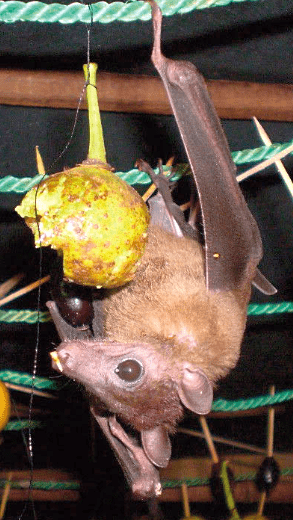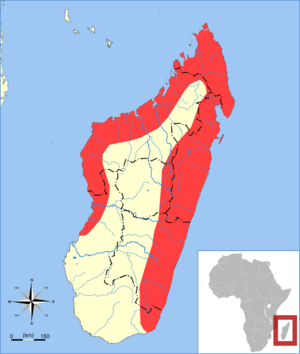Madagascan rousette facts for kids
Quick facts for kids Madagascan rousette |
|
|---|---|
 |
|
| Conservation status | |
| Scientific classification | |
| Genus: |
Rousettus
|
| Species: |
madagascariensis
|
 |
|
| Madagascan rousette range | |
The Madagascan rousette is a special type of fruit bat found only on the island of Madagascar. It lives in warm, dry forests. This bat is also known as the Madagascar rousette. It is a megabat, which means it is a large bat, but this species is actually quite small for a fruit bat.
Contents
About the Madagascan Rousette
The Madagascan rousette is the smallest of the three fruit bats that live only in Madagascar. Its fur is grey on top and a lighter grey underneath. Like many other fruit bats, it has a face that looks a bit like a dog's. It has a long, pointed nose, big wide eyes, and ears that are set far apart.
These bats often live in caves. This suggests they might use echolocation to find their way around in the dark. Echolocation is like using sound waves to "see" objects. The Madagascan rousette is part of a larger group of 10 different Rousettus fruit bat species. You can mostly find them on islands in the western Indian Ocean.
Where They Live and What They Eat
Habitat
Madagascan rousettes usually live in forests. They often rest in caves during the day. However, some bats have been seen outside of caves. This means they might sometimes rest in tree holes or other hidden spots.
These bats move around a lot within the forest. This suggests they help the forest by spreading seeds and pollinating flowers. They have been seen eating fruits and nectar from local trees. They also eat fruits that are not native to Madagascar. They often look for food in eucalyptus forests.
Health and Bats
Scientists study bats to understand how they might carry viruses. This is called "disease ecology." Madagascan rousettes have shown signs of having been exposed to viruses similar to Hendra virus, Nipah virus, and Tioman virus. This means these viruses might have been present in Madagascar before.
The Nipah virus is known to cause serious illness in humans, like fevers. These viruses belong to a group called Paramyxoviridae. People in Madagascar sometimes hunt and eat these bats. Because of this, scientists are studying if there is any health risk. More research is needed to fully understand these risks.
Challenges for Madagascan Rousettes
Forest Loss
Forests where Madagascan rousettes live are sometimes cut down. This is called deforestation. Scientists are still learning how much this affects the bats. Some bat groups have been seen living far from forests. More studies are needed to understand how deforestation impacts them.
However, there are efforts to protect these bats. Local laws help keep them and their roosting places safe within nature reserves.
Natural Predators
Barn owls, a type of owl found in Madagascar, sometimes eat Madagascan rousettes. Scientists found that in one area, about four out of five meals for these owls were adult rousettes. This is interesting because barn owls don't always hunt large bats.
One idea is that the owls prefer to hunt the larger bats. Another idea is that the bats are not always easy to find, especially when they are raising their young. This might explain why the owls don't always eat the rousettes.
Human Visitors
Many tourists visit Ankarana National Park, where Madagascan rousettes rest during the day. Scientists have studied how human visitors affect the bats. They found that bats become more alert and fly more when people get too close or shine lights on them.
The biggest effect was when people got very close (about 5-6 meters) and shone lights directly on the bats. The smallest effect was when people stayed further away (12-14 meters) and did not shine lights directly on them. Interestingly, bats that did not see many tourists were more easily disturbed, even from a distance. This suggests that bats can get used to human visits if they happen often.


